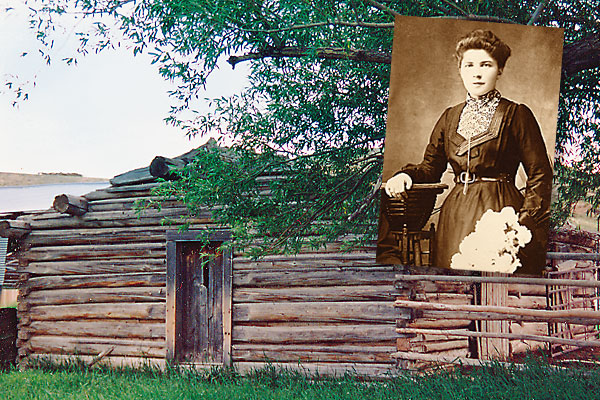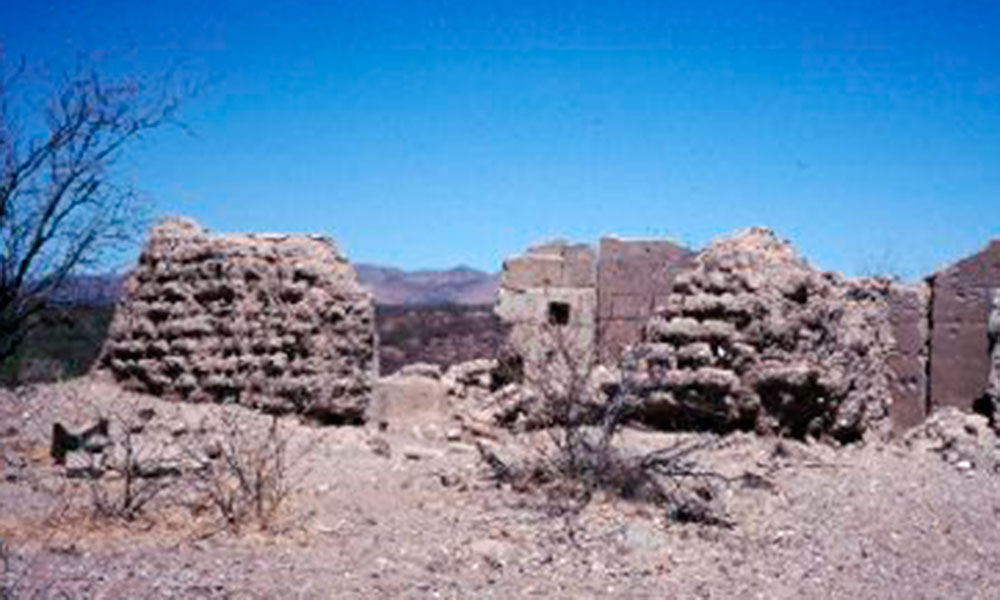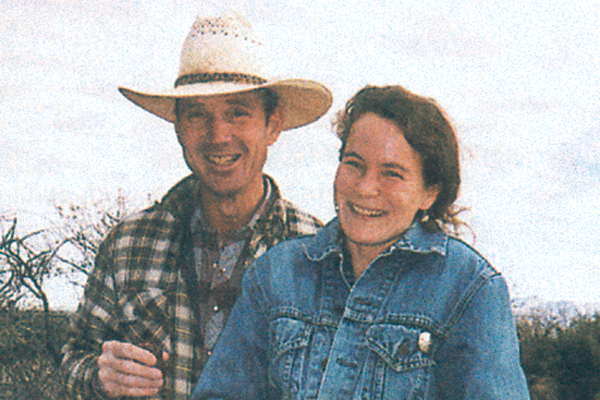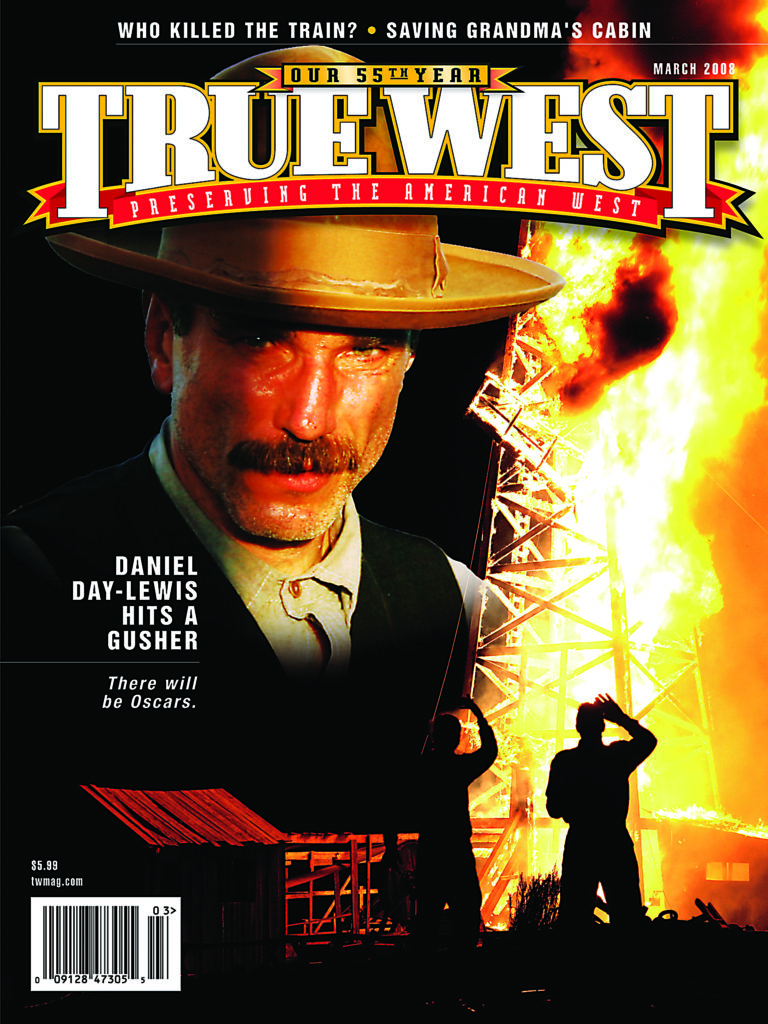
Anybody looking at the rotten foundation logs, the caved in roof, the shoved in southeast corner of the cabin would mark it for demolition. Unless, of course, the old log building represented a piece of family history. Even then a rational person might think it was beyond repair and salvage, would throw up his hands and walk away.
Nobody ever called me totally rational, and that is how a project known in my family as “Candy’s hair-brained idea” began.
During the early spring of 2003, ranch hands using a big tractor with a dozer blade pushed in the corner of the cabin so they could ram a drill through a too-small gate. I saw the damage when I drove by on the way to town. For a few weeks, it gnawed at me that the total destruction of the cabin seemed eminent. I lamented the fact to my husband. “We ought to save it,” I told him, and he raised his eyebrows and shrugged his shoulders. Perhaps he figured it was idle talk on my part.
But then Steve made a mistake and took me with him to a fertilizer sales dinner, and I found my opportunity. The manager of the ranch was at the same dinner. I walked over to him and asked the vital question: “Could I have that old cabin?” He looked at me as if I’d gone daft. Undaunted, I added, “It was my Grandma’s homestead cabin, you know.”
Obviously he didn’t.
Before he had a chance to sidle away from me, I went for the close, “I’d move it to my house.” Now he realized this was his golden opportunity to get an old building out of his way and do so without effort on his part. “Sure, you can have it,” he said, as he turned from me and saw Steve, “Whoops, maybe I just said the wrong thing.”
That dinner was almost exactly 100 years from the day my Grandma first saw that homestead cabin in southern Wyoming, 10 miles from the then-booming copper mining town of Grand Encampment.
Home, Sweet Home
Wild onions took root on the sod roof of Grandma’s homestead cabin and became snacks for my sister and me when we’d climb up the fence and onto the top where we had a view of the horse pasture, barns and corrals, plus our own house across Antelope Creek to the east.
We lived in the big house that had been built circa 1914 by my Grandpa Vyvey to replace the homestead cabin where Grandma spent her first years in America. But the cabin was taken care of well. It was the place where the first of my Grandma’s children were born, where she’d made Belgian donuts and rocked her baby girl who died as an infant, where boys rough-housed and where she learned to speak English after her children started attending the one-room Beaver Creek School.
After the new house was built, more children came into the family, including my dad Fox. The older boys still slept in the homestead cabin as it became the first ranch bunkhouse. Eventually it had other uses: tack shed, granary, storage area.
Through the years, other log buildings at the ranch sagged with age, were moved or dismantled, but Grandma’s cabin was carefully maintained for more than 90 years. Let me tell you some of the story.
Grandma Vyvey
In 1901, my grandmother, Emma Vermeersch, who worked as a maid for a wealthy family in Moerkerke, Belgium, was making bobbin lace when a very tall, very thin Belgian stopped before her. Peter Verplancke (originally spelled Ver Plancke) was 19 years older than Emma, and he offered her an opportunity she likely never expected would come her way.
Peter had been to America where he claimed a homestead in Wyoming on a small stream that flowed from the Sierra Madre. He told Emma she could marry him and travel with him to America, where she would never have to make bobbin lace again.
My grandmother and Peter arrived on the stagecoach in Grand Encampment in March 1903, and set out on foot for Peter’s homestead, 10 miles southeast of town. By the time they reached the Brownlee Ranch five miles from town, Peter was carrying my grandmother into the face of a full-scale blizzard. They spent the night at the Brownlee Ranch and went by wagon on to the homestead, arriving at the cabin that would be their home on March 20.
The homestead was already productive. Exactly when Peter immigrated to America isn’t known, but by 1894, he had established himself among a community of Belgians in southern Wyoming. As the Saratoga Sun reported on May 18, 1894, “Peter Ver Plancke of Collins has put in 55 acres of wheat and oats this spring and planted two and one-half acres of potatoes, besides a good garden. The Belgians are known for their steady thrift and hard toil, and Mr. Ver Plancke is no exception to the rule. He is a man of much intelligence, great strength, and untiring energy, and will soon hew himself a home out of the rough, natural surroundings of that region.”
He already had hewn a home, literally, from the pine trees that grew on Evening Star, a ridge above the ranch on the east slope of the Sierra Madre. The cabin he built had two rooms with long windows on all sides and doors into both rooms. Each log was skillfully blazed flat on one side to form the interior walls. Peter also carefully cut smaller poles and shaped them into triangular chinking pieces, and he added a board floor. Eventually the walls were lined with muslin and the door and window trim painted with blue milk paint.
At the homestead, Peter and Emma began improving their ranch, adding more crops, enlarging the garden and having children. Six years later, in October 1909, my grandmother was set to give birth to her fifth child. Peter left her to get a neighbor woman to help. It was a fateful trip. When he opened a gate, the team spooked and as Peter tried to climb aboard the wagon to stop the runaway, it careened over him.
Peter died nine days later, leaving my grandmother with their five children: Helena, Lillian, Alice, Sam and the baby, William “Butch.” She could speak no English, had a ranch to run and desperately wanted to return to Belgium, but she had no money to pay passage for her and the children.
For two years, she ran the homestead with the help of Charles Vyvey, another Belgian whom Peter had hired in 1907, and then she married him in 1911. In the meantime, she had taken more homestead land in her own name and she had registered the VX brand. She began another family with Charles: Carl, John, Rene, Albert, Grace and Arthur “Fox,” my dad. Their first-born daughter Ruth had infantile paralysis and died of diphtheria and pneumonia as a baby.
Years passed. The ranch established a reputation raising draft and saddle horses. My aunts and uncles broke them to ride and drive; the girls were as good at the job as the boys. The two eldest girls also milked dozens of cows every day until they were in their late teens and took off for Colorado to lead their own lives. Lena returned home, claimed her own homestead and eventually moved to Saratoga. Lillie remained in Colorado where she killed herself, or perhaps was killed by a lover-the family story isn’t clear on that detail.
One by one, the older children moved on to other ranches, to jobs in the woods (cutting ties and timber) and some claimed homesteads, but they eventually sold the land to their parents. My dad and his brother Bert stayed on the ranch with their families. My grandmother died when I was only five, and by the time I was a teenager, the ranch was a 3,200-acre cattle ranch that my Grandpa had sold to Dad and Uncle Bert.
Then, in 1990, my parents and my Aunt Phyllis sold the ranch; Uncle Bert had died three years earlier. Even after the first sale, we had close ties to the owner and both Steve and my brother worked for him. Then he sold out, severing all our connections for several years.
It was hard for my family to leave the VX Ranch; my dad had been born and lived in the same house for 70 years. Once when I was about 10, he tore up some floorboards in the front room of Grandma’s cabin, looking for a 50-cent piece he had lost between the cracks in the floorboard when he was just a child. At the time he lost it, his mother wouldn’t let him take up the boards to retrieve the money and he just knew it was still there in the dirt beneath the floor. We dug and sifted dirt all one afternoon but never found the precious coin.
Although it was fully intact when my family sold the ranch, by 2003, the cabin was just a falling down skeleton. A flood had come one year, and the rushing water slammed into the cabin. The then-rotting logs that formed the base for the sod roof broke and crashed inward, dumping several inches of dirt onto the cabin floor. Later, to get their equipment though the gate, ranch workers had pushed in one front corner so the cabin was no longer a solid structure.
The ranch changed hands twice more before that fateful day at the fertilizer dinner, but the new manager is a young guy I’d known since he was a toddler, which is probably what gave me the courage to ask if I could have the cabin.
The Wham! Oh! Project Begins
A century after Grandma first saw it, her cabin was mine, but there was still the double-daunting task at hand. We had to first move it from its original location to our property, a mile and a half to the southeast. Then we had to restore it. Steve and I couldn’t do all of that alone, so we did the only thing possible: I called my sister and told her I had a project and needed some help with it.
She told our cousin Roxie, with whom we had grown up at the ranch, “Guess what my sister’s hair-brained idea is this time?”
In spite of her name-calling, I’ll be forever grateful that she and her husband Bill were there with us as Steve and I began the not-too-inconsiderable job of preparing the cabin for the move. We’ve done other work together: building or renovating houses, their mountain cabin, shops for Steve and Bill. We jokingly call our joint enterprise WAMO Construction (the name is formed from the first two letters of our last names: Walters and Moulton). It could just as easily be from our style of doing work: Wham! Oh!
While Steve and Bill dug out the corners and began jacking up Grandma’s cabin, Penny and I started shoveling old straw and dirt and removing broken roof logs from the interior. The guys used chains, cables and straps to hold the logs of the walls tightly together as inch-by-inch we raised the cabin out of the dirt. Dad was there, helping Penny and I shovel, and assisting Steve and Bill with their work. Every weekend and many evenings in September 2003, we prepared for “The Move.”
Finally the cabin was ready to be loaded onto an equipment trailer that my nephew Brad borrowed from his boss, Joe Glode of Shively Hardware North in Saratoga. The big day was to be October 11, 2003, and my family will never let me live down the fact that I was not present. I had a prior commitment in Texas, so when they loaded Grandma’s cabin onto the trailer, hauled it to our place and set it down on the foundation Steve and I had prepared, I missed all of the action.
Once we had it in place at the new site, nothing happened for almost a year. Ranch work is naturally cyclical, and Steve had no time for my cabin project in spring and summer, and during the winter in Wyoming, you can’t work on such a job. But come September, when the haying is finished and the cattle are back on fall pasture, we have time to work on the cabin and we’ve done so every year.
We’ve cut and hauled logs to replace rotten ones. For replacements, we retrieved some of the old logs from the house built in 1914 that my Dad and I both grew up in, which was demolished not long after we moved the cabin. Steve and I argue at times. He prefers to remove old boards and logs, and replace them with new ones; I want to keep as much of the original in place as possible.
With Penny and Bill’s help, we put the front walls back into position because we had chained them together and moved them separately from the main cabin (the dozer had effectively separated them from the main structure before we began our work).
Funding for this project has come in fits and starts, which affects how quickly we can complete the work. I sold some articles and we bought cement for the foundation pillars plus rough lumber for floor joists, and paid $20 for enough old plywood to cover the surface so we have a temporary floor. Last fall, with the walls back in place, we made the final big push. We got new logs for the roof purlins and to serve as rafters, purchased rough cut lumber for the roof decking and then covered it with rolled roofing and topped it all with cedar shake shingles (deciding not to restore it with a sod roof as it had originally). It is now boarded up for winter, but this year we will put in doors and windows (some of which were salvaged from the old Beaver Creek School).
Before long, Grandma’s cabin will be fully restored. It cost just under $3,500 for all of the materials we have put into the cabin, plus many hours of our time. It’s been a labor of love on my part, and a bit of coercion to involve all the family members who make it possible to save this piece of our heritage.






